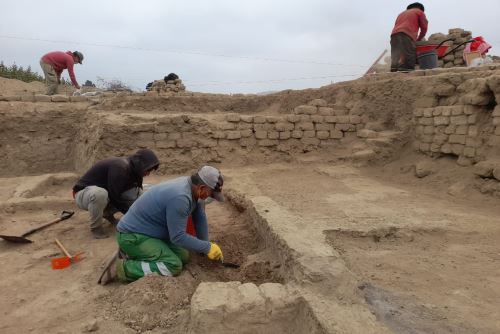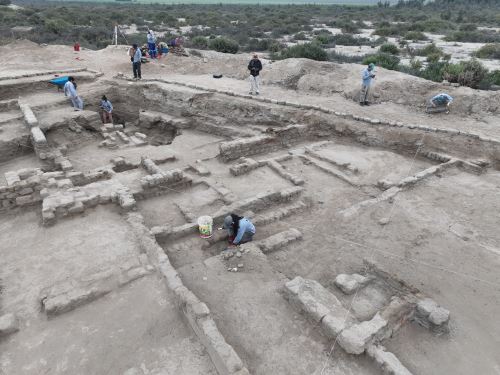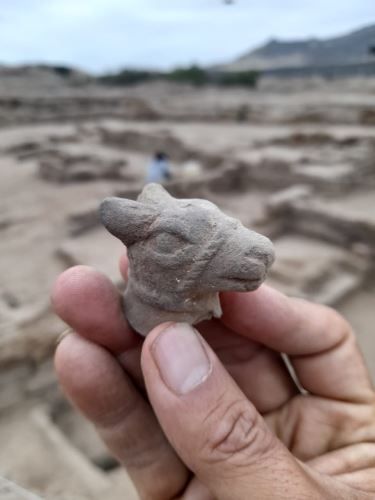A pre-Hispanic building that is believed to have served as a residence for elite figures is the new discovery within the Licapa II monumental complex of the Moche archaeological site in La Libertad region, northern Peru.
"We can speak of a small palace of a local elite that controlled the economy and politics of the area," Henry Tantalean, co-director of the Chicama Archaeological Program at the National University of San Marcos, told Andina News Agency.
The archaeologist specified that the building is approximately 1,400 years old, a conclusion reached after preliminary carbon-14 tests determined that it dates from between AD 600 and 700.
In that sense, it is an architectural example of what in the field of archaeology and history is called the Late Moche Period, the specialist explained.
"This historical stage of Licapa is closely connected to the influences and multiregional interactions of what is known as the Middle Horizon, in which the Wari Empire was one of the main actors," he detailed.

Prolonged work
Tantalean pointed out that excavations at this site in mid-2024 yielded the first indications of the existence of a building that, due to its characteristics, could have been "a residence for the elite."
"This year we have been able to confirm what we had hypothesized," he stated, noting that the characteristics of the structure found —the way it is built and its colors— distinguish it from other enclosures found at the site.
Tantalean indicated that in this type of mansion or palace, a separate area was found —through a wall between one meter and one and a half meters high— from the areas used for craftwork and domestic tasks.
Beyond that separation lies what he described as "a residence for the elite," made up of five adobe-built spaces. The exterior part is painted yellow, he added.
"We are talking about the possible residence of the curaca or of the people who ruled this site,” the archaeologist indicated. The building itself “is evidence that there was an elite that politically and economically controlled the communities," Tantalean said.
This is inferred from the nearby location of areas for pottery and metallurgical artisans, for example, and from the control of trade networks as well, he indicated.
Objects found
Regarding the ceramic remains discovered at the site, the archaeologist indicated that they are not common pieces, but rather "of great quality, highly decorated with special iconography" typical of Moche culture, with scenes of warrior fights, for example, as reflected in the vessels found.
These —he added— "were not only used in burials but also in the daily life of the elite."
Licapa II is located in the Chicama Valley, La Libertad region.
It is estimated that its peak as a populated center in pre-Hispanic times occurred after that of the area currently known as El Brujo, located in the Magdalena de Cao district, Ascope province, La Libertad region.
In Licapa, according to findings at the archaeological site, people, animal species, and objects also arrived from other parts of what is now Peruvian territory and from neighboring countries.
In this regard, Tantalean indicated that objects have been found at the site which could have been brought as offerings or tributes for the residents there, thus denoting their status as members of an elite.
These include capuchin monkeys from the Amazon, Andean camelids, and coastal birds, he noted.
With respect to other objects found, the expert indicated that pieces of ceramic from Cajamarca, textile fragments, and food remains have been found.
Regarding the latter, he pointed out that the presence of lucuma and other fruits, as well as bones of edible animals, indicates that the people who lived there enjoyed a special diet.
Special protection
Tantalean also revealed that, in order to uncover the structure found, the archaeologists had to remove a layer more than one meter high, made up of adobe bricks.

Each layer or level was made up of approximately 200 adobes, around a thousand in total, and they were placed when the residents abandoned the building.
"This great effort to cover this residence is a sign and indicator of its importance and the respect it was given," Tantalean indicated.
"We have no other explanation," he added, noting that this protection has favored the preservation of the enclosure.
Currently, the Chicama Archaeological Program continues excavation and research work on the mentioned discovery.
At the time of writing this note, ceramic fragments with diverse shapes continue to be found, including those of Andean camelids, such as llamas.
Tantalean pointed out that the Chicama Archaeological Program —co-directed by him and Carito Tavera— also counts Charles Stanish, PhD in archaeology at the University of South Florida, among its principal members. The university funds this research as well.

(END) FGM/JMP/MVB
Published: 8/24/2025